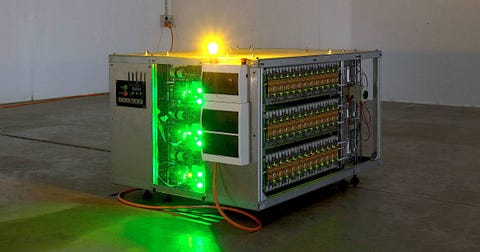
Used electric car batteries are getting a second life—as cells on the power grid.
Relectrify, an electronics company based in Melbourne, Australia, is currently working on a pilot with American Electric Power and Nissan to use expired batteries in building industrial energy storage. The technology, called a battery management system, could boost lithium-ion battery life by about a third and reduce overall costs by half.
At laboratories in Japan and Australia, the company is currently integrating old Nissan LEAF batteries into a larger battery pack. Traditionally, these packs are limited in capability because they're only as good as their weakest battery cell. But Relectrify combines battery management with inverters to get the most out of each individual cell.
Conventional battery management systems monitor and allow some balancing for each battery cell, but since the whole pack is centrally controlled, it becomes problematic as the cells age at different rates and begin to exhibit different storage capacities. As the batteries are emptied in a standard battery management system, the whole pack dies and stops providing power when the first battery cell is depleted, as shown in the video above.
Relectrify ensures that the battery management system not only monitors the individual cells, but also controls power to and from each cell. The system identifies which battery cells are weak and draws less energy from those while continuing to pull power from the stronger batteries. One of the great benefits is if there's a dud, the system can disengage that individual cell.
This explains the ability to employ used electric car batteries: all of the cells' capacity and life can be harnessed, even if it doesn't match that of surrounding cells. As it happens, electric vehicle batteries that have reached the end of their lives still have a good portion of their original energy storage capacity intact, which means they can be used in other applications, like home solar power storage or for use in industrial grade energy storage systems.
Each block in the Relectify system contains 400 individual battery cells, according to the company, and the system can leverage the full lifespan of each. Just one AC battery block from Relectrify can provide 72 kilowatt hours of energy storage and up to 25 kilowatts of power. Meanwhile, Tesla's Powerpack—which serves the same function as the Relectify system, providing energy storage infrastructure for consumers, businesses, and commercial utilities—provides up to 50 kilowatt hours of energy storage per unit.
Relectify's new method is expected to cut the costs for grid storage systems by about $150 per kilowatt hour, according to Bloomberg. Right now, the average price for similar tech using new batteries, like Tesla's Powerpack, runs about $289 per kilowatt hour.


0 Comments